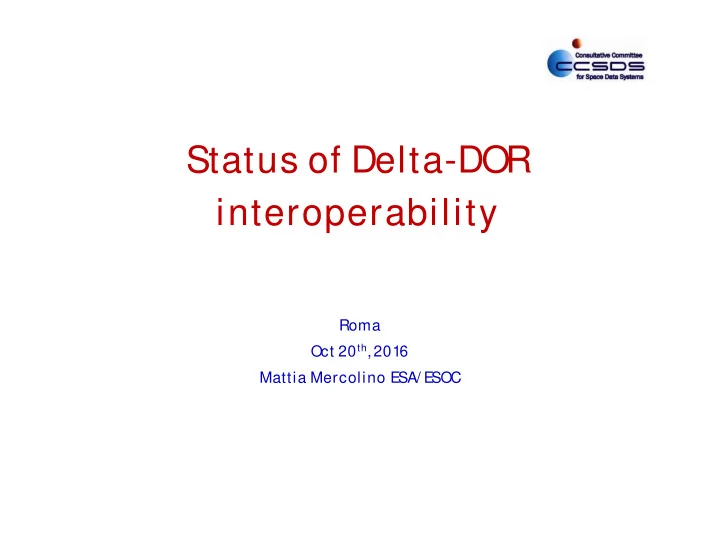

Status of Delta-DOR interoperability Roma Oct 20 th , 2016 Mattia Mercolino E SA/ E SOC
Summary Study on improved Delta-DOR performance Ka-band Quasar catalogue activities Full Delta-DOR interoperability validation with JPL / JAXA / BITTT / FSA EXMO support TTCP test/deployment Radiometer deployments Antenna array
Study on 1nrad DDOR Addressed in a dedicated presentation
Ka-band Quasar catalogue activities [1] Activities in MLG PRSR temporary import expired. Sent back to JPL Expected to be back to MLG soon Needed also for Cassini support Dual freq. Revised X-band quasar catalogue just published First issue of Ka-band Quasar catalogue still TBC Several papers published (last at ESA TT&C conference Sept 2016) Comparisons with GAIA?
Ka-band Quasar catalogue activities [2] Proposed activities in CEB JPL requested the possibility of a temporary installation of the PRSR in CEB to allow frame-tie with Robledo. The PRSR can be temporary installed in CEB (following what was done in 2012) However at the moment it is not possible to have the same network arrangement (direct VPN connectivity) that we have with the PRSR in MLG Also, FEC upgrade including star track functionality is still in the planning cycle for November 2016 Another PRSR will be installed in NNO (Cassini support)
Full interoperability validation [1] With JPL: MRO/Maven – Completed (any report)? With JAXA: can be done on Hayabusa-2 (TBC) With BITTT: outstanding (ESA provided RDEF to china, apparently processed with good results) With FSA: ESA provided RDEF files to FSA. Files were correctly interpreted. Plans for more validations in the frame of ExoMars 2020 (TBC)
E XOMARS support [1] ExoMars support triggered a number of activities: Latency requirement (16hours in critical phases) SNR for quasar (2-bit quantisation issue) 6 nrad committed accuracy (on-board frequency estimation issue) System improvements IFMS open loop adjusted to allow actual 2-bit quantisation Correlator improvements New frequency estimation module Faster processing (I/O handling) Data transfer (it used to be limited to 2Mb/s) From CEB: 50 Mb/s (actual 45 Mb/s) From MLG: 40 Mb/s (actual 35 Mb/s) From NNO: 20 Mb/s (actual 18 Mb/s)
E XOMARS support [2] ExoMars support: 64 passes (half CEB-NNO / half CEB-MLG) + 4 test passes First two test failed Out of remaining 66 passes only 1 failed (plus 1 less data) Most of passes provided 3 DDOR points 24-h latency always accomplished Critical mission phases supported with 4-6 h latency for correlated product delivery
E XOMARS support [3] Few details still to be worked out
TTCP test/ deployment TTCP has passed the Factory acceptance and is now being tested at ESOC OL functionality 16 channels (max 32 Msps per channel) Max BW = 160MHz (can actually cover more, if needed) RDEF output E2E of full TTCP planned in the period February-April 2017 This will include all TC / TM / coding / Doppler / RNG and DDOR (OL) tests. DDOR tests will be done by using EXMO suitcase Plan of initial deployment: Q2/Q3 2017 in CEB and MLG (1TTCP per station in parallel with 2 IFMS). A bit later in NNO. After commissioning at the stations 3IFMS replaced by 2TTCP per station NNO will be updated in 2018 (TBC) Decommissioning of IFMS immediately after
Other activities [1] Deployment of Microwave radiometers at ESA DS sites A HATPRO (humidity/temperature profiler) has been deployed in Cebreros in November 2014 Main purpose: to collect attenuation statistics at X/Ka band Can also be used to provide good estimations of tropospheric wet path delay under testing (preliminary results good, more longer campaign being planned) A second instrument has been procured for installation in MLG (current timeframe for installation: beginning 2017) Will be used (upon demonstration of improved performance with CEB) also for DDOR measurements A third instrument was also procured for NNO site. Installation foreseen in 2017/2018 Prototyping of Tropospheric Delay Calibration System (TDCS) for Radio-Science experiments. Target completion date end 2017
Antenna Arraying Development of off-line correlator for antenna arraying Purpose: develop algorithms and proof-of-concept for (future) on-line correlator Only possible baseline is CEB-MLG (sufficient overlap and collecting area) Will include demodulator and decoder Will be tested on flying mission (probably EXMO) It will be able to interface with the current receiver for SLE interface Project start date: Jun 2016 Expected finish date: Q4 2017
Recommend
More recommend